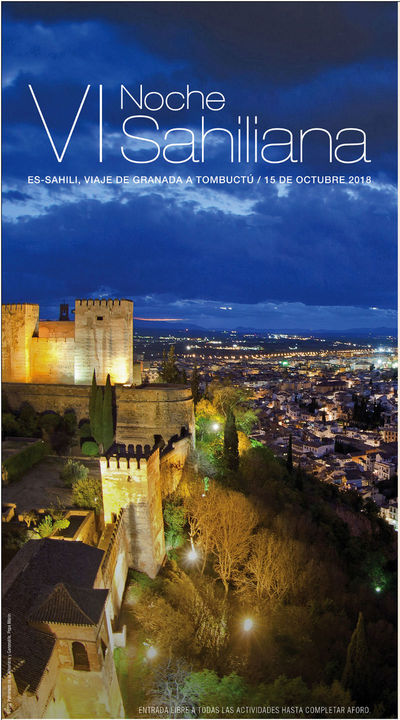Special programs
Index / Activities / Special programs / Casa Árabe contributes to the sixth “Sahilian Night”
Casa Árabe contributes to the sixth “Sahilian Night”
October 15, 20187:30 p.m.
CÓRDOBA
Casa Árabe Auditorium (at Calle Samuel de los Santos Gener, 9).
7:30 p.m.
Free entry until the event’s capacity is reached. VERY LIMITED CAPACITY
The event, which commemorates the exile from Granada to Timbuktu of
Al-Andalus poet and architect Es-Sahili, will be held on October 15 in
Granada. Casa Árabe’s headquarters in Cordoba will broadcast the poetry
reading and homage concert live.
For yet another year, the Alhambra will be remembering Granadan poet and architect Es-Sahili (Granada, 1290-Timbuktu, 1346) with various activities, planned for the dates of October 14 and 15. For the first time, at this edition the music and poetry will be taken to other stages, including the Palace of Villalegre (Guadix), the Virgen de las Nieves Hospital, the Albolote Penitentiary Center and the headquarters of the Solidarity School Foundation in Granada.
Moreover, for all those members of the public who are unable to attend the recital, a streaming broadcast of the poetry and music event has been planned in the Plaza de los Aljibes on Monday, October 15. The broadcast can be watched from Casa Árabe’s headquarters in Cordoba, and through the official profiles of the social networks of the Alhambra and Generalife Board of Trustees.Starting as of 7:30 p.m., music and poetry will round off this edition of the Sahilian Night schedule. Actor Chema Caballero (The Nose Theater) will give a dramatized performance of the figure of Es-Sahili, with a reading of poems given by Ángela Muro, Encarna Pastrana, Suhail Serghini and Ismael Diadé, with guitar accompaniment by Reynir Hauksson, and a musical performance by the duo Koras: Manuel Ballena Gurumbé and Sirifo Kouyaté.
Poet and architect Abu Ishaq Ibrahim al-Sahili (1290-1346), known as Es-Sahili, was born in Granada to a wealthy family that lived between that city and Malaga. His father held important positions in the administration of the Nasrid sultanate, and he eventually held similar posts, being named Secretary of the court at the Alhambra. Es-Sahili was persecuted by Granada’s ulemas and had to go into exile in Africa.
Es-Sahili traveled through the Middle East and Mecca, and met the King of Mali, Kanku Musa, who he followed into the heart of Africa. There, as an architect, he built the first Mosque of Gao, the Great Mosque of Yingareyber and the Madugu Royal Palace, all in Timbuktu. At today’s border between Guinea and Mali, he built the Palace of Niani, and along the curve of the Niger River, you can still find many buildings in his unique style, known as “Sudanese.” Es-Sahili died in Timbuktu in 1346, and his remains rest in the Mosque of Yingareyber. The mark he left behind has reached us today, and he has had a major influence on artists of the stature of Gaudí and Míquel Barceló.
Full program
Moreover, for all those members of the public who are unable to attend the recital, a streaming broadcast of the poetry and music event has been planned in the Plaza de los Aljibes on Monday, October 15. The broadcast can be watched from Casa Árabe’s headquarters in Cordoba, and through the official profiles of the social networks of the Alhambra and Generalife Board of Trustees.Starting as of 7:30 p.m., music and poetry will round off this edition of the Sahilian Night schedule. Actor Chema Caballero (The Nose Theater) will give a dramatized performance of the figure of Es-Sahili, with a reading of poems given by Ángela Muro, Encarna Pastrana, Suhail Serghini and Ismael Diadé, with guitar accompaniment by Reynir Hauksson, and a musical performance by the duo Koras: Manuel Ballena Gurumbé and Sirifo Kouyaté.
Poet and architect Abu Ishaq Ibrahim al-Sahili (1290-1346), known as Es-Sahili, was born in Granada to a wealthy family that lived between that city and Malaga. His father held important positions in the administration of the Nasrid sultanate, and he eventually held similar posts, being named Secretary of the court at the Alhambra. Es-Sahili was persecuted by Granada’s ulemas and had to go into exile in Africa.
Es-Sahili traveled through the Middle East and Mecca, and met the King of Mali, Kanku Musa, who he followed into the heart of Africa. There, as an architect, he built the first Mosque of Gao, the Great Mosque of Yingareyber and the Madugu Royal Palace, all in Timbuktu. At today’s border between Guinea and Mali, he built the Palace of Niani, and along the curve of the Niger River, you can still find many buildings in his unique style, known as “Sudanese.” Es-Sahili died in Timbuktu in 1346, and his remains rest in the Mosque of Yingareyber. The mark he left behind has reached us today, and he has had a major influence on artists of the stature of Gaudí and Míquel Barceló.
Full program

